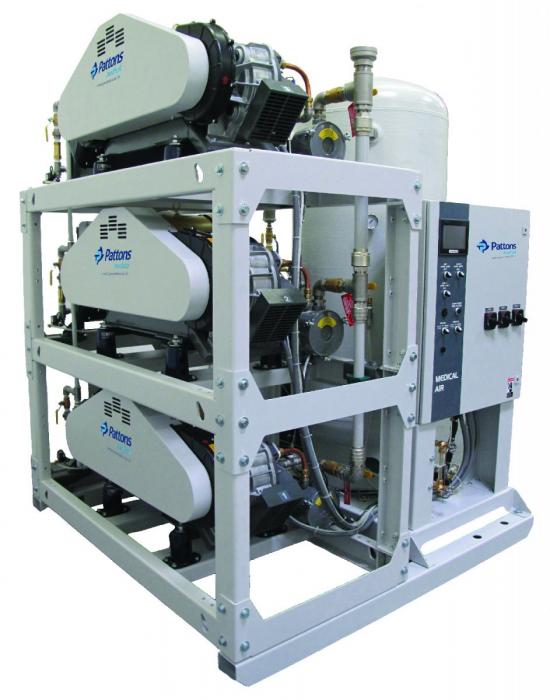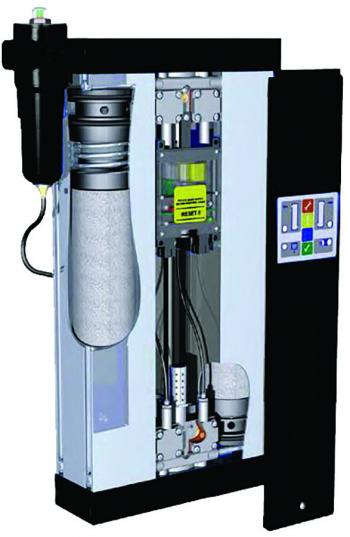A patient in the hospital who needs assistance breathing, either during surgery or through a ventilator, is administered medical air. Medical Air is defined in National Fire Protection Association (NFPA) Code 99 2018 in 5.1.3.6.1 to have the following characteristics:
- It shall be supplied from cylinders, bulk containers, or medical air compressor sources, or it shall be reconstituted from oxygen USP and oil-free, dry nitrogen NF.
- It shall meet the requirements of medical air USP.
- It shall have no detectable liquid hydrocarbons.
- It shall have less than 25 parts per million (ppm) gaseous hydrocarbons.
- It shall have equal to or less than one milligram per cubic meter (mg/m3) of permanent particulates sized one micron or larger in the air at normal atmospheric pressure.
The air is delivered through a distribution piping system that ends with a medical air outlet within the room. Outlet requirements per room are governed by American Institute of America (AIA) Guidelines for Design and Construction of Hospitals and Healthcare Facilities.
Equipment is plugged into the medical air outlet to treat the patient. Many studies have been done determining the load required for medical air compressors. The sizing can be calculated using several methods. The U.S. Typical Method is the standard calculation for medical air in the United States. To calculate by this method the following steps are taken:
- Count all outlets that will be served by this system by occupancy.
- Multiply by simultaneous use factor.
- Add the sum of all occupancy.
- Add the number of ventilators.
This sizing process attempts to size by “worst case scenario,” which means all rooms would be occupied and using some amount medical air. Ventilators being the largest consumer of medical air especially adds to the total. It is highly unlikely all outlets would be used at one time in a facility; however, the facility has to be prepared and equipped for that scenario. This leaves many facilities frustrated with what they consider grossly oversized medical air compressors.
Medical Air Central Supply Systems
NFPA 99 5.1.3.6 details the requirements and the limitations of medical air central supply systems and their installation within a healthcare facility in the United States. The defining requirement 5.1.3.6.2 Uses of Medical Air states that medical air sources shall be connected to the medical air distribution system only and shall only be used for human respiration and calibration of medical devices for respiratory equipment.
Medical air cannot be used in central sterile, to run instruments, or any other use outside of patient respiration. Therefore, multiple air compressors are used within a healthcare facility, but this article will only focus on Medical Air Central Supply Systems.
Oil free air compressors are used to eliminate the potential for hydrocarbons. The most common technologies are scroll, reciprocating, and rotary screw air compressors. In addition to the air compressor, the package normally contains aftercoolers, dryers, filters, receiver and monitoring equipment, such as a dewpoint monitor and CO monitor.

Shown is a 15-horsepower (hp) triplex scroll medical air package.
Redundancy Requirement: An Important Sizing Factor
No one point of failure is allowed to ensure patient safety. NFPA 5.1.3.6.3.9 (B) states that medical air compressors shall be sufficient to serve the peak calculated demand with the largest single air compressor out of service. In no case shall there be fewer than two air compressors.
This means redundancy is required and one air compressor is never allowed. The smallest would be a duplex package. The redundancy also applies to filtration and dryers as well. When sizing an air compressor, it is important to size with the load being maintained even with one unit out of service. Therefore, in a triplex skid, two air compressors can run with one as backup. A quad package can run three and so on. The air compressors will still all run in sequence to maintain even run life on all the air compressors.
An efficient way to meet the peak calculated demand and satisfy the redundancy requirement is with multiplexing smaller horsepower (hp) units. In the past, large industrial air compressors were installed, with large being 30- or 50-hp in medical air applications. This means if one Operating Room is put into use, or one ventilator is brought on-line, a 30-hp air compressor would be started up to meet the demand. This air compressor would run two to three minutes, meet demand, and shut off. This cycle is repeated throughout the life of the unit.
By multiplexing smaller hp air compressors, such as 10- or 15 -hp machines, a facility can reduce their electrical consumption. When a demand is created only one air compressor runs. If that one air compressor cannot meet the demand, then another air compressor can come on and so forth (with one staying off for redundancy). Therefore, the facility is running one 15-hp air compressor versus a 30-hp machine. In the majority of applications, only one air compressor handles the load.
Multiplexing also allows for expandability. Healthcare construction projects are often open-ended leaving flexibility in the services that the hospital is going to provide. Also, due to budget constraints, sometimes space is left shelled for future expansion. Instead of guessing at the future or sizing for future, it is possible to put expandable panels and leave space on skids for future modules. This keeps capital costs down, and the facility will have a clearer understanding of its medical air usage.
Finally, multiplexing multiple scroll air compressors takes dramatically less space, saves considerable money on installations and has lower capital costs than Variable Speed Drive (VSD) rotary screw air compressors. Pattons Medical can have a complete medical air package with multiple scroll air compressors shipped as a complete single point connection package. In new construction, this will save the contractor any additional piping and electrical wiring for components. There would be a braze for the inlet/outlet and one wiring connection. For replacement equipment, the skids can be broken apart to fit through a 30-inch door and have unions for the connections when put in place.
The Ins and Outs of Desiccant Dryer Technology
Dryers are an integral part of the medical air compressor package and can have an impact on the sizing and efficiency. To maintain the requirement of a maximum dewpoint of 32 °F at 50 to 55 psi at any level of demand, and allow for flexibility in skid design, desiccant dryers have become the standard for medical air packages. They perform well in low-flow conditions that are common with medical air demand.
Desiccant dryers utilize towers that contain cartridges of activated alumina. The cartridge design versus loose desiccant eliminates dusting from desiccant and is sized based on demand. Therefore, the amount of air purged will be dramatically reduced requiring less demand from the air compressor. Desiccant dryers require a purge to regenerate the desiccant to continue the ability to dry the air. It is imperative for efficiency with medical air to utilize controls for demand-based purging. The dewpoint is monitored through the dewpoint sensor. In demand-based purging, the purge does not take place until the dewpoint reaches 14 °F. This almost eliminates the air compressor running for purge outside of demand. Another benefit is the dryer can be mounted horizontally or vertically to achieve smaller footprints of the overall package.

Desiccant dryers use cartridges of activated alumina that need to be periodically replaced.
Meeting the Needs of Smaller Healthcare Facilities
During the last 15 years, smaller healthcare facilities have been built to offer less acute services. These facilities are either located on the campus of larger hospitals or found as standalone buildings.
For these applications the sizing of the medical air is the same, however, the loads are much smaller. High-pressure manifolds utilizing medical air cylinders are allowed by code to deliver medical air. This requires the owner to make a financial decision of either a larger capital cost of an air compressor or the ongoing operational cost of purchasing medical gas cylinders.
If the owner decides to install a medical air compressor, the space allotted for medical air compressors is usually quite small. The location is also much closer to patients than in a large hospital setting. This led to the scroll type air compressors being used for medical air. Scroll units are much quieter and smaller than either of the reciprocating or screw type. By utilizing vertical tank configurations and appropriately sized desiccant dryers the skids can be as small as three by four feet.
Involve Medical Gas Specialists in the Process
It is imperative in a replacement scenario that a facility meet with a medical gas specialist to have a medical gas survey completed. This will confirm the sizing done initially for the facility was accurate and will address any changes in acuity or services since the original air compressor was installed. The medical gas specialist will confirm the outlet counts, interview respiratory therapist, and determine if there are any code issues that will need to be addressed with a replacement. Specifically, that the inlet is code compliant and the master alarm panels have the appropriate points. Oftentimes this is missed and can affect the new air compressor being certified.
About the Author
Shannon McAfee, Vice President of Sales and Business Development for Pattons Medical, is a chemical engineer with more than 18 years of experience in the medical gas industry.
About Pattons Medical
Founded in 2008 and based in Charlotte, North Carolina, Pattons Medical sells and services medical air and vacuum equipment nationwide. Compressed air system products include scroll air compressors, reciprocating air compressors, and medical air dyers. Medical vacuum pumps include rotary claw pumps and oil-less and lubricate rotary vane vacuum pumps. It also offers an extensive line of medical air system accessories. For more information, visit www.pattonsmedical.com.
All photos courtesy of Pattons Medical.
To read similar Medical Air articles please visit www.airbestpractices.com/industries/medical.




